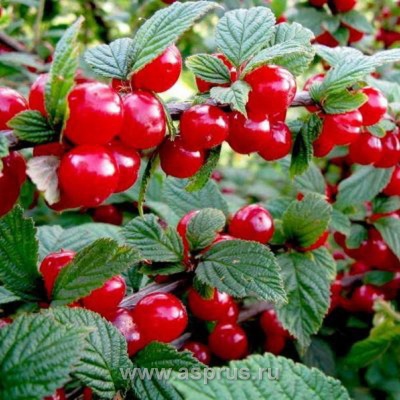
- Authors: Tsarenko V.P., Tsarenko N.A.
- Appeared when crossing: Summer x pollen mixture (seedling Pink + Red)
- Year of approval: 1999
- Barrel type: bush
- Growth type: medium-sized
- Crown: oval, medium density
- Escapes: thick, brownish brown, pubescent
- Leaves: small, dark green, wrinkled, with a double-crested edge
- Flowers: saucer-shaped, average size 2.6 cm in diameter of the rim
- Flowering and fruiting type: solid along the branch: on annual and perennial wood
Among the variety of cherry varieties, varieties that can take root and bear fruit in almost any climatic conditions are especially popular. These include the cherry variety Skazka.
Breeding history
Felt cherry Skazka appeared at the Far Eastern Experimental Station of VNIIR in 1986. The authors of the variety are breeders Tsarenko V.P. and Tsarenko N.A. As parental forms, we used Leto cherry and a mixture of pollen from a seedling Rose and variety Red. This crop appeared in the State Register of Breeding Achievements of the Russian Federation in 1999. Recommended for cultivation of cherries throughout the country.
Description of the variety
The fairy tale is a medium-sized bush with a neat oval crown, which is moderately thickened with dark green leaves. The cherry bush is characterized by upright branches of a grayish color with pronounced peeling, young brown shoots with noticeable pubescence and triple pointed buds deviated from the shoots. In a favorable environment, a bushy cherry tree grows to a height of 110-130 cm.
Cherry blossoms fall on the period from 20 to 26 May. At this time, the bush is abundantly covered with beautiful pink five-petal flowers. The formation of ovaries is continuous, along the entire branch, and only on one-year and two-year wood. Each inflorescence has 1-2 flowers.
Fruit characteristics
Cherry Skazka is a large-fruited variety. The berries have an elongated oval shape with a rounded top. Cherries weighing 3.3 grams grow. Ripe berries are evenly covered with a maroon color with a glossy surface. The abdominal suture is stripe-shaped. The skin of the berries is thin, smooth, with barely noticeable hairiness. The berries are kept on a stalk of medium thickness. The separation is semi-dry, so the berries cannot be transported over long distances. Cherries have a short shelf life.
Berries have a universal purpose - cherries are eaten fresh, compotes are boiled, used in cooking, canned, frozen and processed.
Taste qualities
This variety is characterized by good taste. The red flesh has a tender, fleshy, slightly gristly and juicy texture. The berries have a harmonious taste - sweet and sour, complemented by a weak aroma. Small bones are difficult to separate from the pulp. The juice is red in color and has a thick and rich consistency. Cherry pulp contains more than 7% sugars and almost 1% acids.
Ripening and fruiting
Fairy tale is a fast-growing variety with medium ripening times. The tree begins to bear fruit in the 4th year after planting. The berries ripen together, so the fruiting stage is short. The peak of ripening of cherries falls on the period from 17 to 24 July. Overexposing ripe berries on the tree is not recommended, as the pulp can acquire strong gristle. The life span of the Tale cherry bush is 15-17 years.

Yield
Despite the compactness of the bush, a rich harvest can be removed from it in a season. On average, one bush gives up to 10 kg of berries.
Self-fertility and the need for pollinators
A fairy tale is a self-fertile variety, so cross-pollination is indispensable. Donor trees should bloom at the same time as this species. The most productive pollinators are the following varieties: Vostochnaya, Alisa and Yubileinaya. Experts recommend planting at least 2 pollinators.
Landing
Cherry seedlings can be planted in the spring, before the growing season, and in the fall, a month before stable frosts. It is important that the distance between plantings is observed - 2-3 meters. Good neighbors for Skazka cherries are mountain ash, grapes, and sweet cherries. A one-two-year-old seedling with a healthy root system is selected for planting.


Growing and care
For cherries, it is recommended to choose a sunny area with protection from strong winds. The bush is planted on a hill, but not in the lowlands, otherwise, due to stagnant moisture, the roots will rot.
The agricultural technology of fruit and berry crops is quite simple - watering during periods of severe drought, fertilizing twice a season, rejuvenating pruning once every 5 years, removing dry twigs annually, furrowing and mulching the soil, preventing diseases, and installing a fine-grained mesh that protects against rodents ...


Disease and pest resistance
Thanks to its good immunity, the variety is not affected by coccomycosis, it rarely suffers from clasterosporia and rust. The only ailment to which cherries are not immune is moniliosis. Pests do not attack cherries, since too hard leaves are an obstacle.
Requirements for soil and climatic conditions
Skazka is a frost-resistant and drought-adapted variety. In addition, cherries easily tolerate heat and short-term shade. It is comfortable to grow a cherry bush on loams, sod-podzolic soils, chernozems and sandy soils with neutral acidity and deep groundwater flow. Liming every 5 years will help reduce acidity.
































































